Last Updated on April 5, 2024
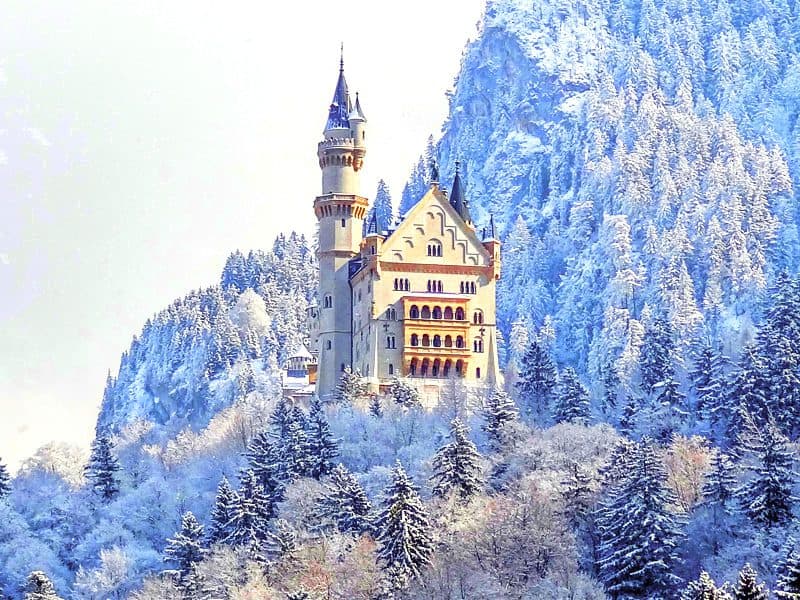
Estimated reading time: 12 minutes
By Jim Ferri
En route to Munich one winter day, my wife and I took a side trip to Fussen, Germany a cozy little Bavarian town snuggled up against the Austrian Border. Fussen is an easy trip from nearby Munich and vice versa.
Fussen is one of the best towns to visit in Bavaria. It has centuries-old streets and buildings, and a palace right in the middle of town. Unbelievably, this little town has not one castle, but two. And one is thought to be the model for Cinderella’s Castle in Disneyland. In fact, the entire town looks like a back-lot set in Hollywood, it’s that attractive. The light dusting of snow that covered everything in sight only added to its enchantment.
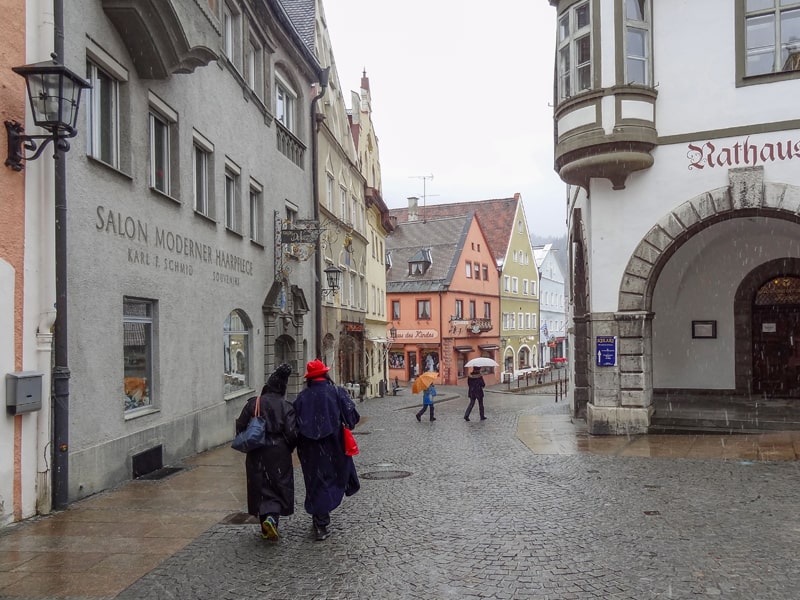
Getting a Guide in Fussen, Germany
Since we had little time to spend in Fussen on our winter foray in Germany, before continuing on to Munich, we made arrangements for a guide with the local tourist office.
Our guide, Erih, collected us at our hotel, the comfortable Luitpoldpark, right after our afternoon arrival and for the next three hours whisked us about the old town. Among other things, we were surprised to learn the little town’s lineage can be traced back to Roman times.
I’ve often found mini-tours to be daunting since guides often want to fit 2,000 years of history into two hours. (On the other hand, you can’t blame the guide since you decide how long a tour will be.) Our tour was interesting both because Erih did a good job of bringing Fussen’s history to life. In addition, the town is compact and easy to maneuver.
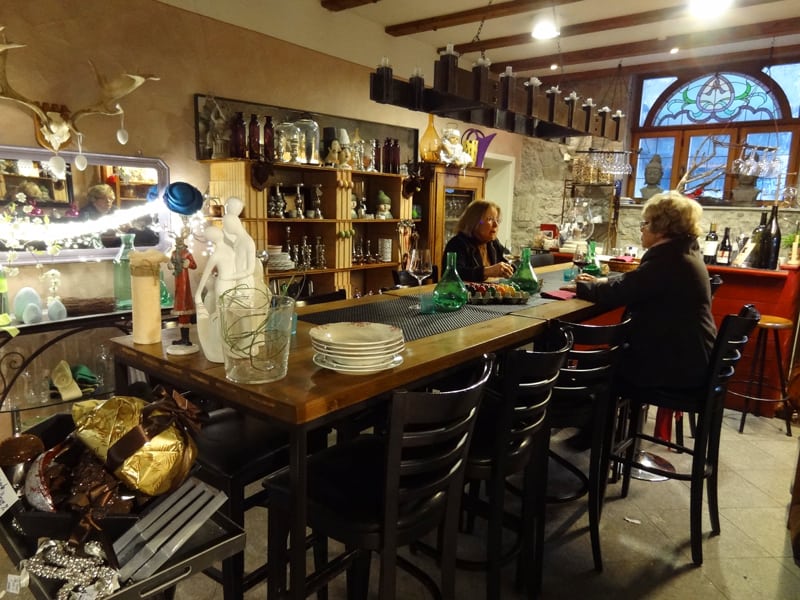
Museum of Fussen
One of the first places she took us was the Rathaus, the City Hall, surprisingly located in an old Benedictine monastery. The monastery was founded in 840, and evidence of Roman barracks dating from the fourth century have been found on the site.
Most interesting, however, was that the old building not only housed civil offices but also a fascinating museum of musical instruments. Visiting Fussen in winter allowed us to have the place totally to ourselves.
The museum’s exhibits are in different rooms, each the former cell of a monk. As we walked through the cells, I couldn’t help but admire all the different musical instruments.
We learned that at one time little Fussen was one of the most important centers in Europe for building musical instruments. That era, however, came to an end following the Napoleonic wars when people were forced to go into the trades and work in factories.
If You Go:
Museum of Fussen, Germany
Lechhalde 3,
87629 Füssen, Germany
[email protected]
Tel: +49 8362 903143
Admission: Adults €6 / under 18 years free
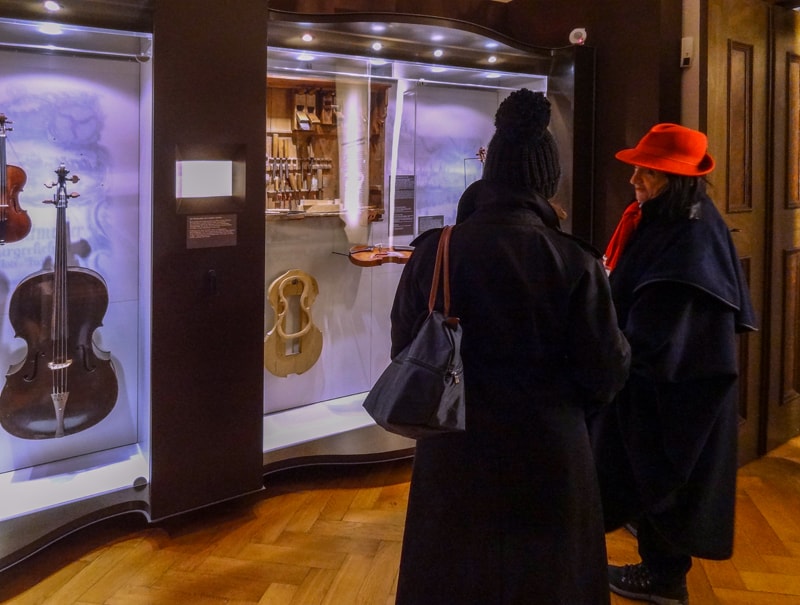
Fussen, Germany: Cradle of European Lute-Making
Fussen, Germany was the cradle of lute-making in Europe. In fact, the first European lute-makers Guild was founded in Fussen in the 16th century. While walking about, in one cell we came upon an exhibit on the making of a lute, beginning with the raw wood from the forest. In another cell, while viewing a dissected violin, I realized for the first time just how incredibly complicated it was to build the instrument.
Over the centuries many of the town’s craftsman drifted off to other European cities. Still, though, the museum presented a wonderful snippet of the musical history of the town. Later, as we wandered the medieval lanes of the old town, I spied the shop of a violin-maker and the history of the place started to come alive.
Erih kept us moving along at a pretty good pace, leading us through little shops and a market. Soon we were through St. Mang, a Baroque church known locally for its organ and the large, early 18th-century-Dragon candlestick on its altar.
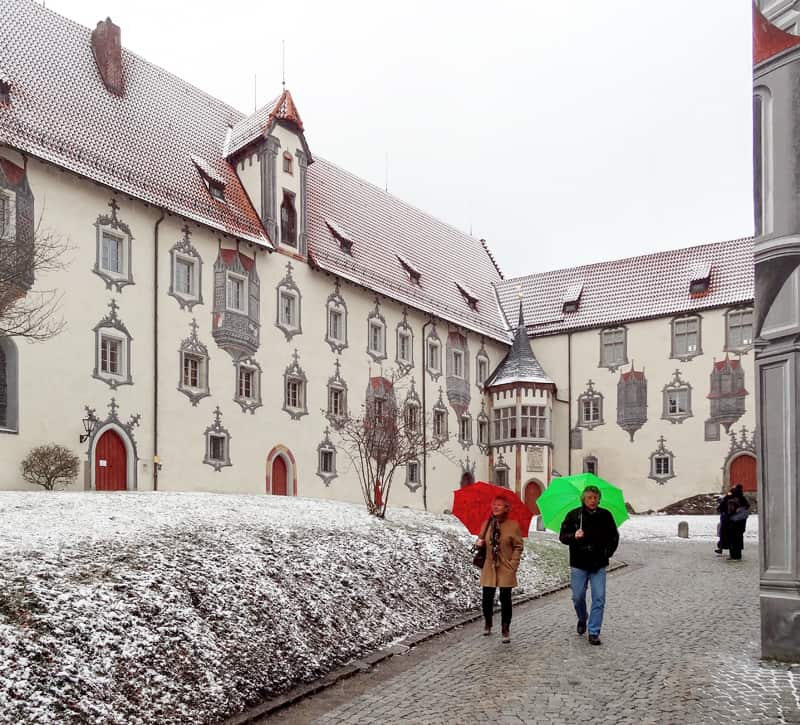
Off To the High Castle
From there we were off to the High Castle, the former summer residence of the Lord Bishops of Augsburg. Again, on that winter day in Fussen we met few other travelers touring Germany.
We were soon at a well-preserved late-Gothic castle complex that houses a museum of paintings. Although the museum was closed that day, Erih wanted to show us the painting done on the exterior of the building. As soon as we entered the courtyard, we couldn’t help but stop and stare for a few moments
From a distance the trompe l’oeil painting on the building had tricked us into thinking it had corner towers and ornate window frames. Centuries earlier one of the bishops had the decoration, first developed in Italy, done on his residence by local artists to impress his visitors.
Although it was a costly style of decoration at the time, Erih told us, the Bishop was flush with tolls from a river crossing not far away.
If You Go:
High Castle
Magnusplatz 10
87629 Füssen, Germany
Tel: +49 8362 940162
Open: April to October: Tuesday to Sunday from 11:00am to 5.00pm / November to March: Friday to Sunday from 1.00pm to 4.00pm.
Admission: Entrance to the garden and courtyard are free. Entrance to the art gallery and the tower is €6 per adult, €8 for a family
You may also enjoy: Day Trips From Munich to 3 Great Bavarian River Towns / Enjoying Christkindlmarkt in Germany / Why Heidelberg is Über Popular With Travelers (Video)

Pork in King Ludwig Beer Sauce
That evening, wanting to sample authentic Bavarian cuisine, we dined in the restaurant of the Hotel Hechten. Since I wanted to stick to strictly Bavarian / Fussen winter cuisine, I ordered a beer and what the restaurant’s English menu described as “Our famous leg of pork in King Ludwig beer sauce with Sauerkraut and a potato dumpling.” It was good, but impossible to finish.
This being Bavarian Germany, in Fussen you’ll find plenty of other pork specialties such as Schweinshaxen (knuckle of pork served with dumlings and red cabbage or sauerkraut) and many sausage dishes. For lunch try a Bavarian snack platter containing various kinds of sausage, bread, and Allgäu cheese. It’s often accompanied by a wheat beer.
If You Go:
Hotel Zum Hechten
Ritterstraße 6
D-87629
Füssen im Allgäu, Germsany
[email protected]
Tel: +49 8362/91600
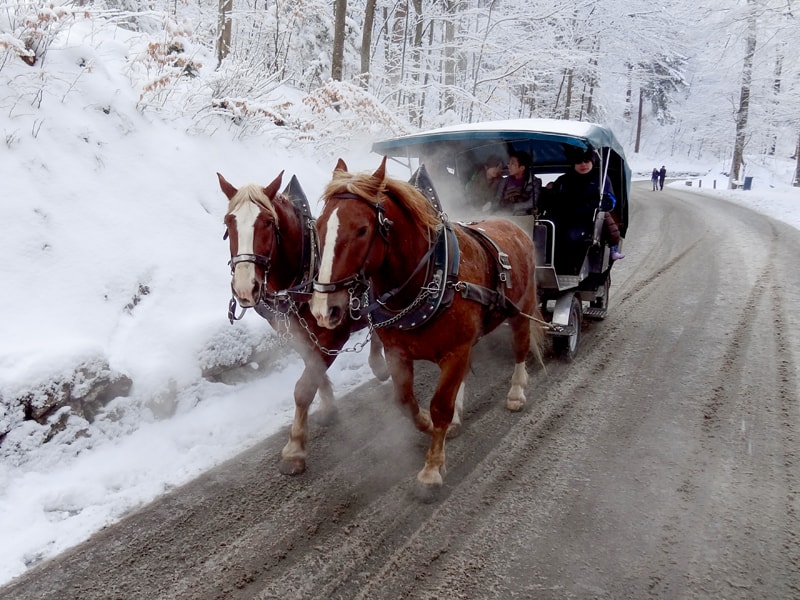
Off to Neuschwanstein
After breakfast the next morning, we set off for Neuschwanstein Castle, the Disney-like bastion built by King Ludwig II, a shy monarch who loved art but hated state affairs. He met death in nearby Lake Starnberg, under mysterious circumstances, leaving the castle unfinished.
Neuschwanstein is about two miles outside Fussen and is the most famous historic building in Germany. To reach the castle you must park in the small village below Hohenschwangau Castle, before making the trip up to Neuschwanstein. On Lake Alpsee, Hohenschwangau was built as a summer residence by King Maximilian II, Ludwig’s father.
The walk takes about 45 minutes and during the summer months you can take a shuttle bus. On our winter day in Fussen we hopped aboard a horse-drawn wagon that cost €7 per person, and another €3.50 for the return. Sitting behind the horses pulling us through the snow-covered woods, it was almost like traveling through a fairytale forest.
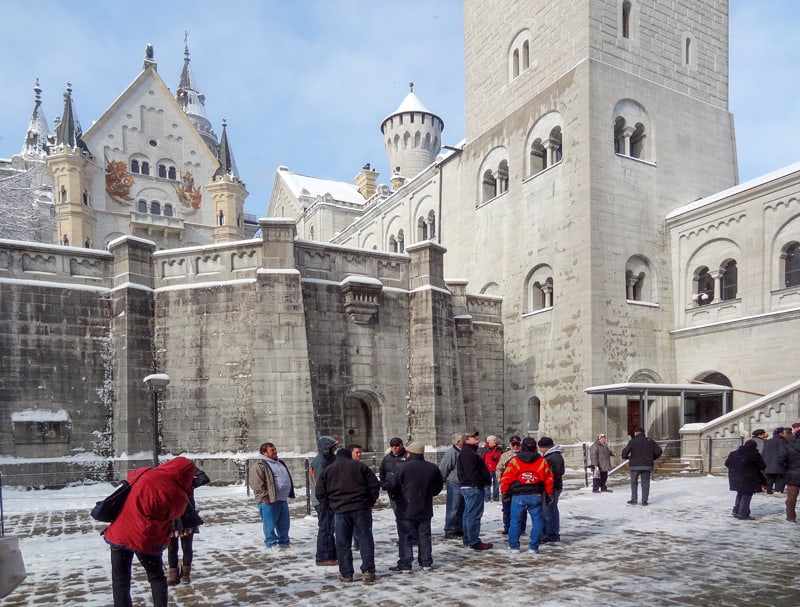
Fussen, Germany’s Spectacular Neuschwanstein
You purchase entry tickets for the castle (€16.30) (note: check current prices below) at the car park. There you receive a tour time in your language of choice. Your tour begins on the second floor, since the first floor was never finished.
Immediately on your arrival from Fussen, you’ll undoubtedly quickly realize that Neuschwanstein is the way a fanciful castle should look in Germany. Ornate painted scenes adorn the walls, huge beams support equally ornate ceilings, intricately carved panels line the halls. Grandeur is everywhere.
In Ludwig’s bedroom alone it took 14 woodcarvers four- and half-years to complete the woodcarvings, which include an exceptionally ornate bed canopy containing miniature replicas of church spires from all over Bavaria. Two secret doors lead to a bathroom and a dressing room.
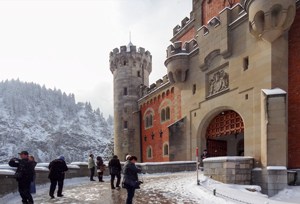
Off the bedroom is the king’s living room, replete with a large ornate chandelier and a wall tapestry painted on linen. There’s also a large porcelain swan, Ludwig’s favorite bird, and the symbol of the castle and Bavaria. From the living room we walked through another doorway and into a fake cave. Off of it was a small balcony for looking out over the beautiful countryside, now covered with newly fallen snow.
If you visit Fussen, you’ll find that Neuschwanstein is most enjoyable in the winter. It’s then when you can enjoy the beautiful royal castle without visiting with a scrum of other visitors, which number about 6,000 per day during the summer.
If You Go to Fussen, Germany:
Neuschwanstein Castle
Neuschwansteinstraße 20
87645 Schwangau, Germany
Note: the ticket center is in the town of Hohenschwangau below the castle:
Ticket Center Hohenschwangau
Alpseestraße 12
D-87645
Hohenschwangau, Germany
Open: Open daily April 1 to 15 October 31: 9 am-6 pm / October 16 to March 31: 10 am-4 pm / closed January 1 and December 24, 25 and 31
Admission: prices vary depending on the individual: go to https://shop.ticket-center-hohenschwangau.de/Shop/Index/en/39901 (Note: if booking online any free admissions require a free ticket to be shown)
Note: Restoration work is currently taking place in the castle. It is expected to last until 2023.
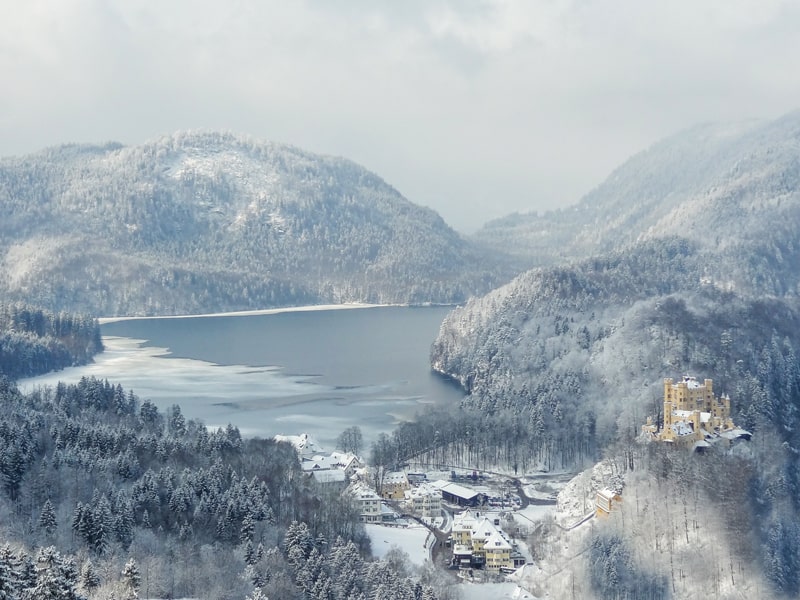
Beautiful Hohenschwangau
We had wished we could have stayed in the castle longer, but the 35-minute tours are timed and another group was following closely behind. We also knew that back in Fussen we had to find a restaurant for lunch before moving on to Munich.
But Erih had one other thing to show us after we took the horse-drawn wagon back down to the parking area. There she whisked us across the street to the Museum der Bayerischen Konige, the Museum of the Bavarian Kings. It was another perfect things to see on a winter visit to Fussen.
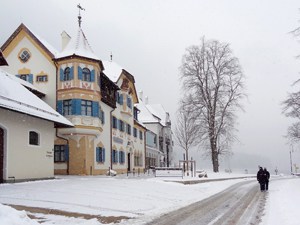
Near Hohenschwangau Castle on the shoreline of the Alpsee, the museum was once a hotel where guests invited on royal hunting parties would stay. Today it is used to relate the story of the castles and the history of the Wittelsbachs, the family of Ludwig II and one of Europe’s oldest dynasties.
It’s quite well done, with the museum offering tours of varying depths and duration and a walk-through family tree. Tours are either guided or on audio guides in eight different languages.
With our time constraints we only had time for a short tour, but our witty guide Heinrich brought royal history to life, lacing together what we had seen with Erih with the history of Bavaria.
When we started our sightseeing in Munich the following day, he already had us well-primed for the tour.
If You Go:
Hohenschwangau Castle
Alpseestraße 30
87645 Schwangau, Germany
Tel: +49 8362 930830
Open: daily April 1, 2021 to October 15, 2021: 9.00am to 5:00pm / October 16, 2021 to March 31, 2022: 10:00 a.m. to 4:00 p.m. / closed December 24th, December 25th, December 31st and January 1st
Admission: prices vary depending on the individual: go to https://shop.ticket-center-hohenschwangau.de/Shop/Index/en/39901 (Note: if booking online any free admissions require a free ticket to be shown)
Museum of the Bavarian Kings
Alpseestraße 27
87645 Schwangau, Germany
Tel: +49 8362 9264640
Open: daily 9:00am to 5:00pm. / closed September 30th, December 24th, December 25th, December 31st and January 1st
Admission: prices vary depending on the individual: go to https://www.hohenschwangau.de/en/mdbk-en/museum/admission-prices
How To Get to Fussen, Germany
Fussen is a great day trip from Munich and several other cities any time of year, although you’ll encounter fewer visitors off season in the winter.
From Munich, the fastest way to get to Fussen is by car. The 80-mile drive, via either the A95 or A96 Autobahn, will take approximately one hour and forty-five minutes.
There is also bus service via FlixBus from Munich to Fussen for approximately $6. The trip is approximately two hours.
There is also rail service between Munich and Fussen. The two-hour trip costs approximately $26 one-way.
Füssen Tourismus und Marketing
Kaiser-Maximilian-Platz 1
D – 87629 Füssen, Germany
Tel: +49 8362 9385-0

Wonderful article.
Thank you Paul. Fussen is a great little town and well worth visiting.